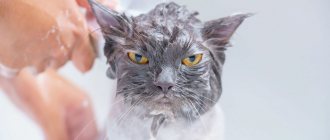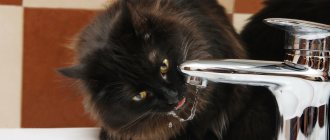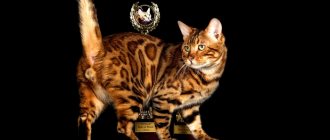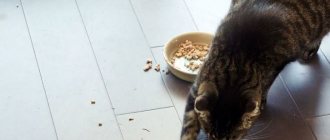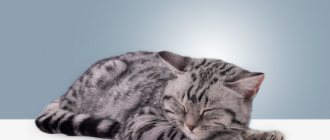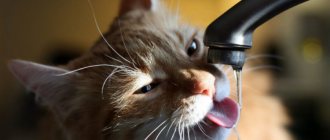A cat's body is 65% fluid. A pet's diet must include not only tasty and high-quality food, but also clean drinking water, which is of great importance for the body. Water takes part in many important life processes and helps dissolve substances entering the digestive tract.
In this article we will look at how to properly give a cat water, how much liquid a cat should be given per day, how to prepare water for drinking, methods for accustoming a cat to water, and answers to popular questions.
How much water should a cat drink per day?
Cats do not need a lot of liquid, but your pet's daily diet must include clean water. Broths and other liquid formulations cannot fully replace regular drinking water. The average daily water intake for a cat is 40-50 ml of liquid per 1 kg of weight.
If a cat eats wet food and eats other nutritious foods well, a certain portion of its daily fluid intake will enter its body. She gets the rest with drinking water. This is why the owner often thinks that the cat does not drink water at all or drinks very little.
The filming revealed the secret of lapping
To explain the nature of lapping, specialist Harold Edgerton from the Massachusetts Institute of Technology conducted an experiment in 1940 in which he used stroboscopic photography. At the same time, it was proven that when an animal laps, it first touches the surface of the water with the upper part of its tongue.
Cats are a unique creation of nature. Flexible, agile, dexterous. Even a drinking cat looks graceful, barely touching the water with its tongue. Not only domestic but also wild representatives of the cat family drink in such an original way: lions, tigers, leopards, panthers. How do cats do this?
What kind of water to give your cat
The health and life expectancy of a cat largely depends on the quality of drinking water. The best option for an animal is soft natural water from drinking sources. This water contains beneficial microelements for the body.
Alternatively, you can give your cat filtered or frozen water. Do not give your domestic cat water from the tap. As a rule, it is not of good quality. In addition, it may contain impurities that are dangerous to the cat’s body.
Preparation
The cat is given drinking water in a clean ceramic or glass bowl. The container must be washed daily.
Temperature
Do not give your pet too cold or hot water. The liquid should be at room temperature.
Supplements
Some owners add various additives to their cat’s water to improve the taste or quality of the drinking composition.
Water additives:
- fluorine, iodine (quality improves);
- tuna juice, anchovies (cats are attracted by the smell);
- nettle infusion (for medicinal purposes);
- special nutritional drink for cats.
The filming revealed the secret of lapping
To explain the nature of lapping, specialist Harold Edgerton from the Massachusetts Institute of Technology conducted an experiment in 1940 in which he used stroboscopic photography. At the same time, it was proven that when an animal laps, it first touches the surface of the water with the upper part of its tongue.
Almost half a century later, the experiment was repeated again. This time the filming was carried out by Roman Stoker, who clarified that the cat's tongue almost does not penetrate deeper than the surface of the liquid. The specialist carried out the experiment by observing his own cat. He had a high-speed camera at the ready. The filming allowed us to analyze the lapping process and draw appropriate conclusions.
When an animal touches the surface of a liquid, a certain part of it, due to the property of adhesion, “sticks” to the cat’s tongue. The column of water that forms between the cat's mouth and the surface of the liquid constantly changes its thickness and height. The nature of cats is such that they instinctively feel at what moment the column of liquid is at its largest. At this time, the animal quickly closes its mouth, as if “biting off” the upper part of the water column.
Answers on questions
Each cat is individual. Some simply drink water without creating any problems for the owner, while other representatives of the feline family are afraid of any liquid and categorically refuse to put their muzzle in a bowl so as not to wet their whiskers.
We have prepared answers to the most common questions that owners of pet cats and cats have.
The cat does not drink water: what to do
A cat's reluctance to drink water may alert the owner.
Insufficient fluid intake leads to dehydration of the body, disrupts the biochemical parameters of the blood, which in turn provokes the development of severe liver and kidney diseases. Before taking measures to correct this situation, you need to determine the reason for the cat’s refusal to drink fluids. Reasons why a cat does not drink water:
- The cat eats wet food. They contain up to 80% liquid, which is quite enough for the animal’s body.
- Reluctance to drink from an uncomfortable bowl. You can try changing the water tank to another one with wider edges, so that it is more convenient for the cat to lap up the water.
- Stale or poor quality water. Cats are very finicky and may refuse to take liquid if it does not meet their needs.
- Serious illness. As a rule, in such cases, the cat refuses not only water, but also food, or consumes it in smaller quantities, without showing much appetite. In this case, the animal needs to be shown to a veterinarian.
Try to find out the reason for the cat's refusal of water. Observe her and if you see that she drinks water from other sources, but categorically refuses to lap up the liquid from her bowl, try replacing it or placing it away from the food bowl. Some cats generally do not drink water if it is next to food.
Special additives that improve the taste and quality of the liquid will also help to accustom your cat to water. Some breeders add a pinch of soda to drinking water or throw an ice cube into a bowl of water. Cats are very curious and may become interested in water if something foreign is floating in it.
If your cat is often outside, there is a high chance that she is getting the amount of fluid she needs from outside sources. These could be ordinary puddles, which, of course, is very unsafe. In this case, the animal can only be retrained by limiting its access to the street for independent walks.
Is it normal for a cat to drink a lot of water?
Excessive water consumption is a clear sign of extreme thirst, which may indicate the development of certain diseases in the cat's body. This symptom is typical for hormonal disorders, diabetes, kidney disease, infectious diseases and febrile conditions.
If your cat drinks a lot of water and there are additional signs of her unhealthy condition, you should immediately take her to a veterinarian, who can determine the exact problem of her unhealthy interest in drinking liquids.
There is no need to worry if a cat that regularly eats dry food drinks a lot of water. With such a diet, the animal must consume a sufficient amount of liquid per day.
Can cats drink sea and salt water?
Cats located far from fresh water can quench their thirst with sea water. Their body filters salt well and removes the unnecessary element naturally. There will be no harm to your cat after drinking salt water, but you should not give it to your cat for daily drinking.
Should I give my cat mineral water?
There are times when a cat accidentally drinks mineral water from its owner’s mug and shows with all its appearance that it quite liked this liquid. Should you give your cat mineral water? Absolutely not, only in the absence of fresh water or for medicinal purposes, as prescribed by a veterinarian. If you regularly give your cat mineral water, urolithiasis may develop.
Should you give your cat boiled water?
Boiled water has a specific taste and, as a rule, cats do not particularly like it. In addition, it is completely useless for the body, so it is not recommended to give such water to a domestic cat. It is better to choose filtered, frozen or bottled water for drinking your pet.
Why does a cat move or overturn the bowl and spill water?
The cat spills water, moves the bowl - what to do? Many animals simply play with water, trying to entertain themselves with something. The reason for this behavior may also be the proximity of the food bowl. Try moving the water container to a different location.
And with this behavior, a cat may indicate the need to change stagnant water to clean and fresh. Change the fluid, not forgetting to rinse the reservoir itself thoroughly.
Watch your cat and learn to recognize her desires! Don't ignore the problem of water refusal or excessive thirst. In any unclear situation, contact your veterinarian.
Lapping mechanism
The question of exactly how cats drink has worried scientists for a long time, and in the 40s of the last century, Professor G. Edgerton from the Massachusetts Institute of Technology used stroboscopic photography to reveal the mechanism of cat lapping.
Work on studying how a cat drinks has been continued in our time with the help of high-speed photography. This slow-motion video clearly shows how a cat laps milk and exactly what movements the cat's tongue makes.
However, Edgerton's conclusions that cats use their tongues as a kind of inverted spoon when lapping turned out to be not entirely correct. A number of scientists from various scientific institutions, including the same Massachusetts Institute of Technology, have proven that it’s all about adhesion (sticking of liquid to the tongue) and high speed of movements.
When is complementary feeding introduced and what to feed?
To accustom a cat to normal food, additional food to cat milk should be introduced no earlier than the baby is one month old. Breastfeeding cannot be denied unless there are contraindications for the offspring and the nursing mother. Dry food is suitable - high-quality any brand or specialized for certain breeds, which is eaten by Scots, British, Persians, Siamese or Maine Coons. If the kitten does not eat solid food, you can force it by spreading it a little in the bowl. Then beef is introduced, later replacing it with chicken or turkey, low-fat cottage cheese, low-fat varieties of fish without bones and fins, boiled vegetables (except broccoli, tomatoes, onions and garlic). Small pets should definitely receive chicken yolk and greens. Veterinarians do not recommend mixing portions of regular food with industrial food, as this negatively affects digestion.
Hello saucer!
A small kitten can be compared to a human child, although this comparison is not very correct. But why is such an allegory given? We gradually accustom our children to other foods, but at the same time he continues to eat mother’s milk or special formulas. You should also behave with small kittens. But if there is no cat, and the baby is still small, not even 3 weeks old, then you will need to feed the kitten milk from a pipette or even from a bottle.
Features of nutrition during the transition period
It is very important to introduce any complementary foods gradually. First, make a simple liquid semolina porridge with diluted milk; no sugar should be added.
After the kittens' stool has returned to normal, you can make liquid milk porridge from rice, rolled oats and buckwheat. In parallel with such food, you can also give low-fat cottage cheese. We must remember that everything that kittens eat will not be eaten right away, so you need to put very little food on the plate.
To eat, kittens can approach the bowl very often during the day, but the frequency should not exceed 6 times. Closer to the age of two months, babies need to be taught to eat more solid foods: boiled meat and fish, sometimes you can give them fresh, but be sure to make sure that they don’t get large bones. The pieces of food should be small; sometimes you can mix pieces of fish with any porridge cooked in water. It is best to use ready-made canned food for young children, but you need to carefully monitor them when they begin to eat such food.
How to train to a bowl?
Now we come to the most important question: when and how to accustom a kitten to a saucer and how long this procedure will take. As mentioned earlier, kittens begin to be interested in the saucer at three weeks of age, or rather, they show curiosity about the food of adult cats. Therefore, this particular age is considered one of the best for teaching a baby to eat from a plate.
At first, the baby will constantly snort and sneeze with milk bubbles. This is due to the fact that he is just beginning to comprehend the science of lapping, because quite recently he only sucked his mother’s milk. You can also sometimes see him reaching directly into the bowl with his paws; this must be stopped immediately.
To do this, you need to take it out of there, wipe its paws with a napkin and place it near the bowl. The next time he gets ready to climb into the saucer again, you need to hold him back. This way you can teach the kitten that limbs should not be in the food.
Why may a kitten refuse food?
Most of the reasons why a baby does not want to eat are not associated with painful conditions. There may be several reasons for refusal.
Stress. If a baby is torn away early from his mother cat or transported from a nursery, he will initially feel uncomfortable in his new home. Sometimes, when changing residence, the kitten completely stops eating and drinking, then for 2 days he never goes to the toilet. This is very dangerous because it causes dehydration and intoxication of a still fragile body.
During periods of stress, you need to show care and attention towards the new resident, take him in your arms. New food. Previously, the kitten received food from its mother, it ate milk
The loss of milk manifests itself as a shock to the kitten’s body. They removed him from the cat early. The kitten simply cannot learn to eat food because it was torn away from its mother early. In this case, he needs to be fed with an analogue of cat's milk, which is sold in pharmacies. If you can’t buy it, goat will do. Dirty dishes often become a factor in refusal to eat food not only for kittens, but also for adults. Also, the animal will not like plastic dishes with an unpleasant odor. Worms and parasites. This causes poor appetite or complete refusal to eat. The kitten loses weight, its fur deteriorates, diarrhea and vomiting occur. In this case, the help of a veterinarian is necessary.
Important! If, in addition to poor appetite, the baby exhibits additional symptoms such as lethargy, diarrhea, and bad breath, then you should immediately go to the clinic. You can’t risk the animal’s health
Cat's milk is an essential food during a kitten's early life. When it reaches 3-4 weeks, you can introduce simple food into the diet - cottage cheese, milk, porridge. You should always watch your baby and his reaction to foods. Then the kitten will grow up healthy, beautiful and well-groomed.
Kittens are born small and completely helpless, then at first all the difficulties fall on the shoulders of the mother cat, but then 3 weeks passed and she needed the help of her owner in order to cope with these little fidgets. At three weeks of age, babies begin to move, they already see, hear, and go to the toilet on their own. Now the owner will have more problems related to caring for this wonderful creature. In addition to the question of how to protect the little fidget, a person will have another question: how to teach a kitten to eat on its own. In our article we will talk about at what age he begins to eat on his own, and how his diet needs to be changed.


